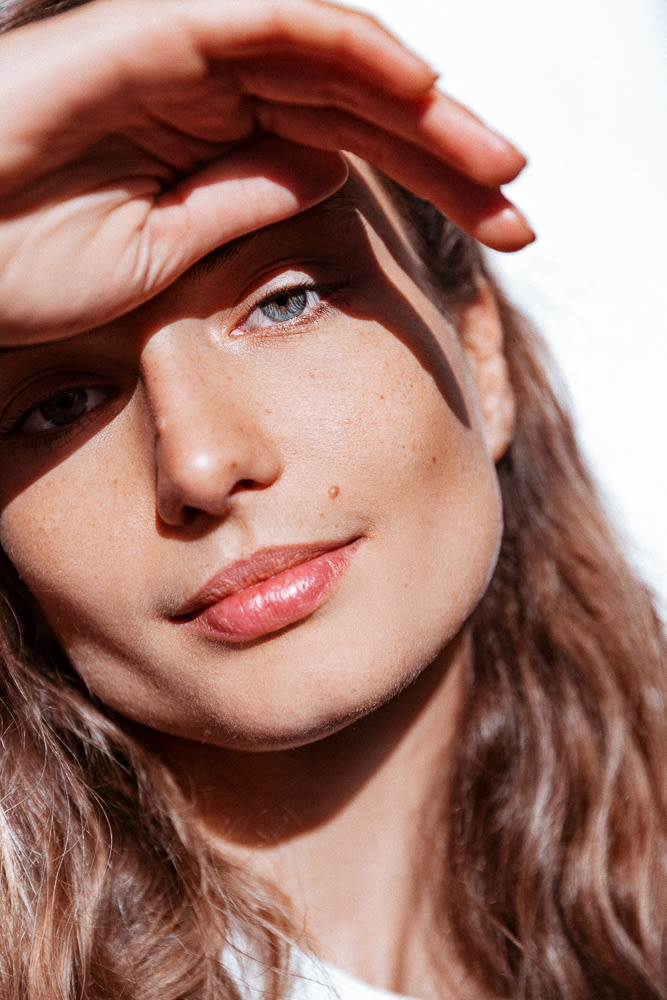Sun 'stache. The mask of pregnancy. I Can't Believe It's Not Hyperpigmentation™. Melasma goes by many names, almost none of which are actually listed here. But no matter what you call it, the hard-to-control facial discoloration is frustrating, and often unavoidable. If it's summer where you are—as it is at press time in New York City—you might be experiencing some darkening around your mouth, under your nose, and on your cheeks right at this moment. (It's not a tan.) Or perhaps you're pregnant (congrats!) and those symptoms sounds familiar. There's also a possibility that neither of those things are true, but you're still seeing some brown spots along your jawline or on your forehead... Sounds like you're struggling with melasma. Stay calm; keep reading for the solution.
ITG talked to two of our favorite facialists, Shani Darden and Renée Rouleau, about their individual approaches to conquering melasma. (Yes, it's conquerable!) Below, they tackle your most burning FAQs. Let's take this one step at a time:
First of all, what is melasma exactly?
"Melasma is a skin condition where light-to-dark brown patches of pigment form on the face due to the stimulation of melanocytes," explains Renée. She goes on to say that, while it's almost impossible to predict if and when melasma will surface, it's often triggered by a change in hormones, caused by pregnancy, new birth control, hormone replacement therapy, etc. Shani says her own melasma flared after her first pregnancy and has continued to develop as she's gotten older. And wiser!
How do I know if it's melasma or just hyperpigmentation?
Very good question. The two can look similar (those pigment patches), but melasma is fueled by hormonal activity, whereas hyperpigmentation shows the residual damage from a zit or other injury to the skin. While they can be treated very similarly, melasma just might come back a bit more eagerly.
I don't see those patches (yet). Am I at risk?
Maybe! Does your mom struggle with melasma? That's a good indicator of your risk, as melasma is believed to be a genetic predisposition, according to Renée. It also tends to affect people with medium-to-darker skintones who live in sunny locales more readily. If you have any upcoming changes in your hormones that you can plan for (pregnancy, menopause, the like), keep a lookout, too. Renée mentions that oftentimes "dark patches come on so gradually that many women don’t even realize it’s happening."
I already have melasma, how do I treat it?
Swiftly! Renée mentions that cells have "memory," so the longer they stay stained, the harder the stains take to treat. (It's the same when you spill wine on your carpet.)
Your first course of at-home action is exfoliation. This is how Shani treats hers: "Retinol Reform has helped tremendously with my melasma, as well as a prescription topical medication from Dr. Simon Ourian—Epione's Restoration Firm & Lift." If it's in your budget, she also recommends seeing a doctor for laser treatments—"I make an appointment with Dr. Ourian every time I return from vacation."
Renée also suggest a variety of acids—anything from glycolic to lactic to mandelic, with some complexion-brightening vitamin C thrown in for good measure. ITG endorses her at-home chemical peel if you don't want to shell out for the top shelf dermatologist treatments. You might see the word "hydroquinone" thrown around as a treatment—but proceed with caution. It's a skin bleaching ingredient that's best used under doctor supervision.
After I've treated it, how do I keep it from coming back?
Sunscreen is the obvious way—you'll want to keep those melanocytes from waking up under UV ray exposure. While you're at it, think about sticking to physical sunscreen instead of chemical. (Most chemical sunscreens work when the ingredients have reactions under the heat—and you want to avoid heat at all costs.) MD Solar Sciences is the ITG go-to at the moment.
Additionally, quit your Bikram yoga, infrared sauna, and hot tub habits. Turn down your shower temperature and stop cleansing with warm water. If you do feel the heat, cool off quickly with a refrigerated sheet mask or some such. You know the drill.
Are there other things I can related to this, specifically on this wonderful site?
Why yes! Thank you for asking. Dayle Breault, go-to facialist of the Kravitz/Bonet clan, has a handy guide to treating hyperpigmentation here. Plus you can get into deeper cuts with both Shani and Renée for all things clear and bright skin.
Also, the comment section is bound to be lit. Make sure to check below for more product recommendations from your fellow ITG readers. Teamwork makes the dream work.
Photographed by Tom Newton.

